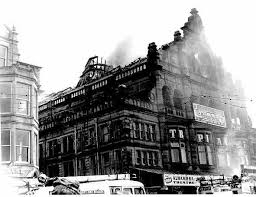
On the same day in 1970 two of Morecambe’s favourite attractions were destroyed by fire – the wooden sailing ship Moby Dick moored near the Super Swimming Stadium and the Alhambra on the West End Promenade.
The announcement of plans to turn the roof space of the Alhambra into a 1,500 seat performance area reminded me of a behind the scenes visit I made in 2015 before its acquisition by current owner Ian Bond.
21st August 2015
The long-delayed exploration of the Alhambra with David Chandler. Met Mike O’Brien at the Lancashire Street entrance who took us round and then left us with the keys to explore on our own.
Began with the modern nightclub area and its resident pigeon. Mike gave us a potted history of the place since the fire in 1970 then we went up and out to enter the roof space. Here there were walkways above the false ceiling of the nightclub. The roof was spanned and supported by the old metal framework. The projection box was still to be seen near which the fire had started (an ice cream cabinet had an electrical fault and set light to some cine film stored nearby) with charred timbers either side where some raised seating had been above the circle. The walkway led to a door providing a view into the stage area.
Examined decorative metal details which formed part of the balustrades. Also had rooftop view across the West End. The backstage areas had survived the fire (the safety curtain and firewall having done their job) but had been greatly altered, especially the stage. A warren of small rooms (presumably dressing rooms), toilets and narrow winding staircases with much original woodwork and decorative ventilation grilles all painted dark grey. Not much in the way of old items, though we did find a japanned stamp (producing embossed stamps) and parts of a very fragile London & NW Railway timetable poster from 1904 which was found hidden on a ledge.
Climbed up to the fly gallery on one side of the stage. This had lots of flats – some stacked in a pile, others leaning against the wall. One was recognisable as a brick wall; others had cut-out shapes and gauze inserts (one was perhaps a cave entrance) with occasional splashes of muted colour showing through the dust and grime. A substantial walkway led along the back wall to the other fly gallery. This had painted and chalked graffiti, notably “Panto 1968/9” and what may have been “Chris”. The grid looked intact above.
Below, the stage was gone making way for the false ceiling of the nightclub. However, its level could be worked out from the sawn-off timbers and the line between painted and unpainted brickwork.
Generally, there were plenty of backstage signs about – no smoking, fire blankets, etc. David took lots of pictures includes including one of an exotic metal figurine on a staircase.
We were disappointed perhaps there hadn’t been more genuinely old stuff hidden away but it was still a rare and special opportunity to take a look round.
Outside, we spotted the metal lions which had helped support the canopy as well as painted signs for Andertons and Child (and Longden) nearby.
Advertisements Share this:




